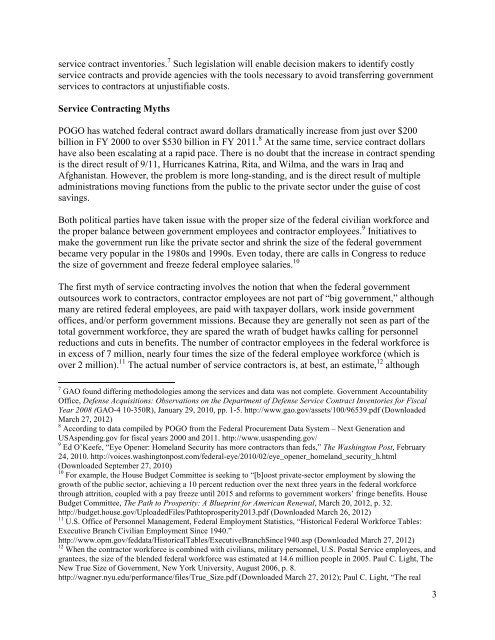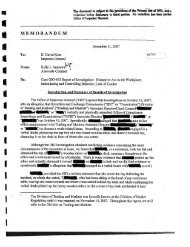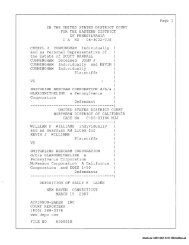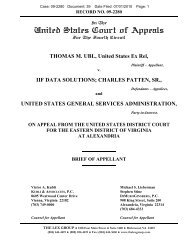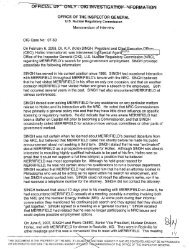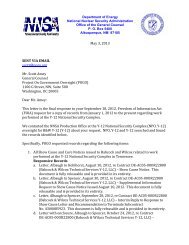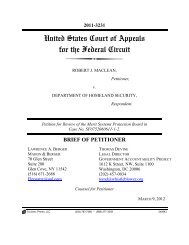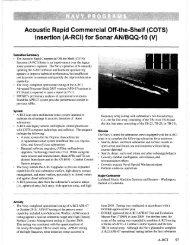SA McCaskill Cost Hearing Final 03 29 12 - U.S. Senate Homeland ...
SA McCaskill Cost Hearing Final 03 29 12 - U.S. Senate Homeland ...
SA McCaskill Cost Hearing Final 03 29 12 - U.S. Senate Homeland ...
Create successful ePaper yourself
Turn your PDF publications into a flip-book with our unique Google optimized e-Paper software.
service contract inventories. 7 Such legislation will enable decision makers to identify costly<br />
service contracts and provide agencies with the tools necessary to avoid transferring government<br />
services to contractors at unjustifiable costs.<br />
Service Contracting Myths<br />
POGO has watched federal contract award dollars dramatically increase from just over $200<br />
billion in FY 2000 to over $530 billion in FY 2011. 8 At the same time, service contract dollars<br />
have also been escalating at a rapid pace. There is no doubt that the increase in contract spending<br />
is the direct result of 9/11, Hurricanes Katrina, Rita, and Wilma, and the wars in Iraq and<br />
Afghanistan. However, the problem is more long-standing, and is the direct result of multiple<br />
administrations moving functions from the public to the private sector under the guise of cost<br />
savings.<br />
Both political parties have taken issue with the proper size of the federal civilian workforce and<br />
the proper balance between government employees and contractor employees. 9 Initiatives to<br />
make the government run like the private sector and shrink the size of the federal government<br />
became very popular in the 1980s and 1990s. Even today, there are calls in Congress to reduce<br />
the size of government and freeze federal employee salaries. 10<br />
The first myth of service contracting involves the notion that when the federal government<br />
outsources work to contractors, contractor employees are not part of “big government,” although<br />
many are retired federal employees, are paid with taxpayer dollars, work inside government<br />
offices, and/or perform government missions. Because they are generally not seen as part of the<br />
total government workforce, they are spared the wrath of budget hawks calling for personnel<br />
reductions and cuts in benefits. The number of contractor employees in the federal workforce is<br />
in excess of 7 million, nearly four times the size of the federal employee workforce (which is<br />
over 2 million). 11 The actual number of service contractors is, at best, an estimate, <strong>12</strong> although<br />
7 GAO found differing methodologies among the services and data was not complete. Government Accountability<br />
Office, Defense Acquisitions: Observations on the Department of Defense Service Contract Inventories for Fiscal<br />
Year 2008 (GAO-4 10-350R), January <strong>29</strong>, 2010, pp. 1-5. http://www.gao.gov/assets/100/96539.pdf (Downloaded<br />
March 27, 20<strong>12</strong>)<br />
8 According to data compiled by POGO from the Federal Procurement Data System – Next Generation and<br />
U<strong>SA</strong>spending.gov for fiscal years 2000 and 2011. http://www.usaspending.gov/<br />
9 Ed O’Keefe, “Eye Opener: <strong>Homeland</strong> Security has more contractors than feds,” The Washington Post, February<br />
24, 2010. http://voices.washingtonpost.com/federal-eye/2010/02/eye_opener_homeland_security_h.html<br />
(Downloaded September 27, 2010)<br />
10 For example, the House Budget Committee is seeking to “[b]oost private-sector employment by slowing the<br />
growth of the public sector, achieving a 10 percent reduction over the next three years in the federal workforce<br />
through attrition, coupled with a pay freeze until 2015 and reforms to government workers’ fringe benefits. House<br />
Budget Committee, The Path to Prosperity: A Blueprint for American Renewal, March 20, 20<strong>12</strong>, p. 32.<br />
http://budget.house.gov/UploadedFiles/Pathtoprosperity2013.pdf (Downloaded March 26, 20<strong>12</strong>)<br />
11 U.S. Office of Personnel Management, Federal Employment Statistics, “Historical Federal Workforce Tables:<br />
Executive Branch Civilian Employment Since 1940.”<br />
http://www.opm.gov/feddata/HistoricalTables/ExecutiveBranchSince1940.asp (Downloaded March 27, 20<strong>12</strong>)<br />
<strong>12</strong> When the contractor workforce is combined with civilians, military personnel, U.S. Postal Service employees, and<br />
grantees, the size of the blended federal workforce was estimated at 14.6 million people in 2005. Paul C. Light, The<br />
New True Size of Government, New York University, August 2006, p. 8.<br />
http://wagner.nyu.edu/performance/files/True_Size.pdf (Downloaded March 27, 20<strong>12</strong>); Paul C. Light, “The real<br />
3


